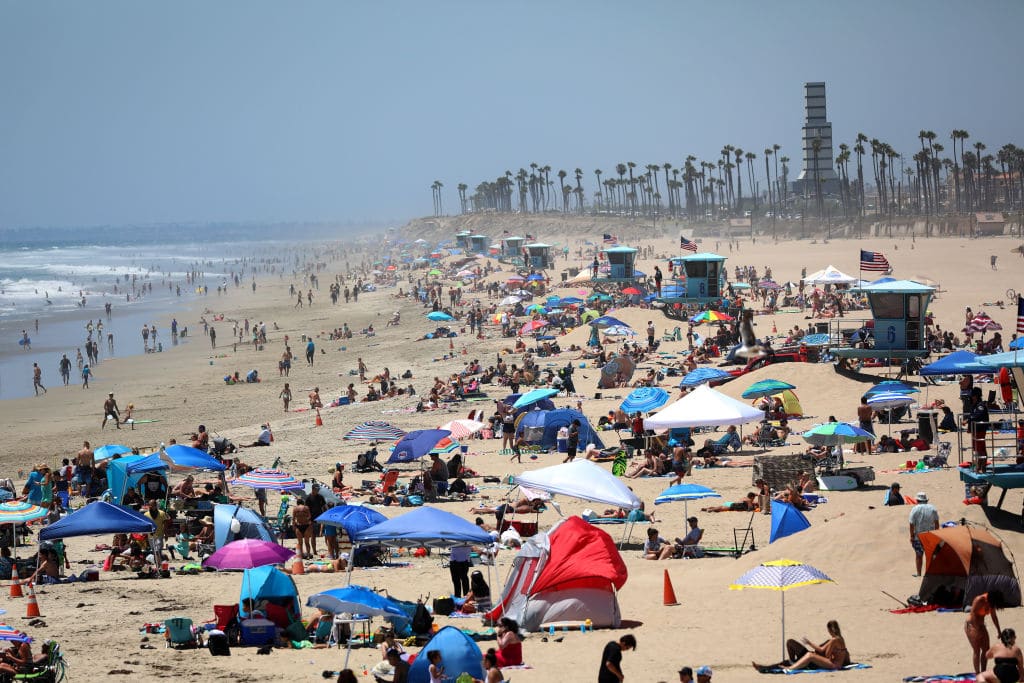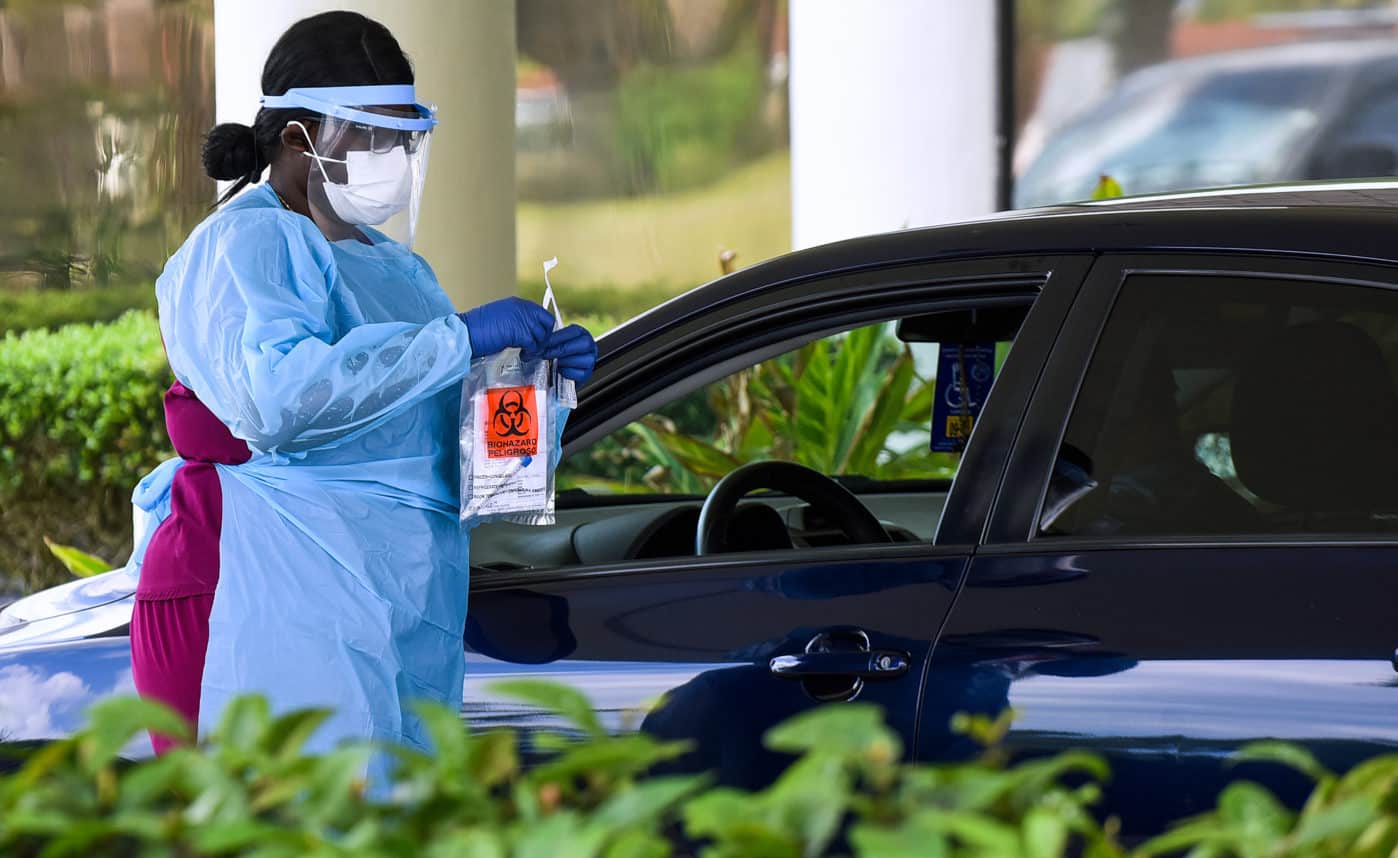 People gather at the beach on July 03, 2020 in Huntington Beach, California. (Photo by Michael Heiman/Getty Images)
People gather at the beach on July 03, 2020 in Huntington Beach, California. (Photo by Michael Heiman/Getty Images) Is the United States, at any level of government, trying to get daily life for Americans back to normal as quickly as possible? Because it doesn’t look like it.
Canada, Germany, France and Britain — comparable, advanced Western nations that also were caught unprepared — have broadly reopened and new daily cases and new daily deaths are trending down.
In the U.S. concern over rising cases* is leading to the reinstitution of lockdowns (California), rolling back re-openings (Texas) and generally slowing down the crawl toward normalcy. Our public health system more closely resembles Brazil and Mexico than Canada or England, which — sorry Brazil and Mexico — is a red flag.
What’s the big deal, you may be asking. The more cases we have, the closer we are to herd immunity. But I think aiming for herd immunity is likely the wrong way to think about our current problem. You can read more about that here and here.
The status quo, though, is also unacceptable. I’ve been severely critical of the lockdowns from the beginning (see here, here, and here). There is no economic or social predictability right now. Open up with tons of restrictions, more infections, lock down again, wait, wait, wait, open up again. It’s Groundhog Day governance, and it gets harder to maintain because we become fatigued and resigned.
When lockdowns end, cases rise dramatically, even with social distancing and masks, until there’s another lockdown. It buys time, but not much else.
What if we had a plan that allowed society to be mostly or even entirely normal; that kept new daily case counts very low; that became easier to maintain over time and would at worst, require occasional moderate restrictions, but nothing like we’ve experienced since March?
The idea is not mine. It’s from a smart friend and I can’t un-see it. The only science-y concept you need to know to understand this plan is Rt. That measures how transmissible the virus is in any given area. Rt can go up or down depending on many factors, one of which is social distancing. When Rt is above 1, the virus spreads quickly. When it’s below 1, it dies quickly.
To illustrate how close we could be to getting rid of COVID-19 in California, and in every state, if California reduces Rt from its current estimate of 1.05 to 0.50 and keeps it around 0.50, the virus could be completely gone by Labor Day. That math also works for Florida and Texas. That’s less of a reduction in transmissibility than California had from March to April during its first lockdown. So it’s doable. But for this to work, California, and every state, needs to be able to prevent the virus from spreading again when restrictions are eased.
How?
A voluntary, cash-incentive program that encourages everyone who was recently in close contact with someone who has COVID-19 to get tested right away, and to voluntarily self-quarantine until they receive a negative test result. This would require an abundance of test kits and enough lab infrastructure and techs so that results can be processed and communicated quickly, ideally within 24 hours.
The federal government would need to underwrite this: billions of dollars for the cash incentives, for the testing infrastructure and for a huge public messaging campaign. Billions of dollars is nothing when the economic cost of shutting down every few weeks is trillions of dollars. And this wouldn’t be a band aid like Congress’s $2 trillion CARES Act. It could be a solution.
Here’s how one version of this could work: Let’s say I saw a friend yesterday. Today, he tells me that two nights ago he was at a bar and the bar just posted on Instagram that one of its patrons tested positive for COVID-19 two nights ago. My friend says he tested positive and that he was paid $30 to test and will be paid $30 for each day he quarantines until a test result comes back negative. He’ll be paid another $10 if I get tested.
I get a test, get paid $30, stay home the next day to wait for that results, get paid another $30. The test comes back positive. I’m home for two weeks making $30 a day and another $10 for every possibly infected contact of mine who gets tested.
How would a local government know if someone who tested positive is self-quarantining? Each city or state could devise its own plan. Maybe set up comfortable quarantine hotels where people could voluntarily live for a couple of weeks. Give people the option of downloading an app. Or just trust people to do the right thing.

Would some people scam the system? Of course. The CARES Act will likely pay out billions of dollars in fraudulent claims. There’s always fraud. But Americans are eager for life to return to normal. Most people who test positive would self-quarantine and not scam the system. And as positive tests trend down, there would be fewer opportunities for fraud. Also, this idea doesn’t require 100% compliance to work. As long as enough infected people test early and quarantine early, the virus could quickly die out.
There would need to be tons of Public Service Announcements all over TV, podcasts and the internet. Runny nose? Get tested, stay home for a day or two, let your close contacts know. We’ll pay you. We’ll pay them. Something like that.
If enough people who should test and self-quarantine do so early, and if you can sufficiently reduce Rt (maybe with no restrictions or with modest restrictions), maybe the virus goes away and stays away if you don’t let up.
You don’t have to cut off every infection. You just have to cut off enough to keep Rt low. And every infection you prevent through voluntary testing, contact-tracing and self-quarantine is one less infection you need to cut off through masks, social distancing and lockdowns — forced restrictions that harm society. And as cases drop, maintaining this type of program becomes easier.
Right now, there are lots of reasons to not get tested even if you probably should. Los Angeles promises free tests to anyone who wants one. I know someone who was tested two weeks ago and still has not received the result. And that was after having to wait three days to even schedule a test that was a 30-minute drive away and took two hours to complete.
Meanwhile, CDC guidelines advise anyone who has been in close contact with someone who has COVID-19 to self-quarantine for 14 days, even if they test negative.
Yes, false negatives are definitely a thing. So on an individual level, the prudent thing to do, especially if you’re in close contact with someone who’s at risk, may be to self-quarantine even if you test negative. But at a societal level, if you want tons of people who to get tested quickly, make it easy and give them money. None of this involves coercion or Chinese-style tracer phone apps. It is entirely voluntary, and therefore American.
If this idea works, we could maybe have Dodgers games, concerts and no masks in seven or eight weeks. And if we kept the system going, the government could spot a possible outbreak before it’s too late. Maybe close down large gatherings for a week or two and then open back up. Nothing nearly as destructive as what has happened since March, and what will continue to happen unless we pivot or get lucky.
Could something like this be the quickest path to a full re-opening? Maybe. And it doesn’t violate our basic liberties. The same can’t be said for the diktats issued since March by so many power-drunk and clueless governors and mayors.

What we’re doing now is not working. We have to try something new. As California locks down again, and as more states move in that direction, there’s an opportunity to do something useful with this bought time; to take advantage of the fact that daily case counts could be very low within a few weeks. There could be an opportunity to set up a program that would minimize the likelihood of a third lockdown.
And the White House and federal government need to step up. States and cities don’t have the resources to build something like this. Our leaders owe us a credible plan that could make America look like America again. If they don’t offer one soon, it may not.
***
For the past two weeks, there have been between 40,000 and 60,000 new confirmed cases every day in the United States. Because we catch somewhere between one in three and one in five infections, that translates to around 120,000 to 180,000 infections daily. This is far lower than the likely peaks in March and April, which were around 400,000 new infections every day.
Disclaimer: Every number referenced in this article except for current and past confirmed cases and deaths is based on current best estimates, and therefore subject to change.
This article originally appeared on The Daily Wire.























 More news and opinions than at a Shabbat dinner, right in your inbox.
More news and opinions than at a Shabbat dinner, right in your inbox.